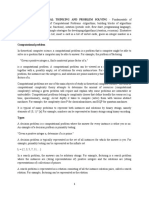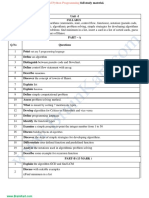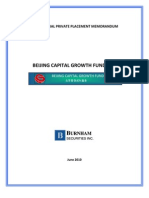Ge8151 Python Programming Question Bank
Uploaded by
Balakrishnan.GGe8151 Python Programming Question Bank
Uploaded by
Balakrishnan.GGE8151 - PROBLEM SOVING AND PYTHON PROGRAMMING
Question Bank
UNIT 1 - ALGORITHMIC PROBLEM SOLVING
Part-A
1) Define Computer
2) Define algorithm
3) What are the two phases in algorithmic problem solving?
4) Why algorithmic phase is a difficult phase?Justify
5) What are the steps involved in algorithm development process?
6) Compare computer hardware and software.
7) State some properties of an algorithm.
8) What are the three building blocks of an algorithm?
9) Define Input , Output , Assignment statement
10) Describe different notations in algorithm and classify each.
11) Define pseudocode.
12) Define the rules to be followed on pseudocode.
13) Define flowchart.
14) What are the different types of flowcharts?
15) What are the symbols used in flowcharting type?
16) Describe the Data Processing Symbols in Flowchart.
17) List some guidelines for drawing flowchart.
18) List the merits in drawing the flowchart.
19) List the demerits in drawing the flowchart.
20) Explain some of the qualities of Programming Language?
21) What is the difference between the algorithm and the program?
22) Give the pseudocode to check the biggest of 2 numbers.
23) State the differences between Iteration and Recursion.
Part-B
1) Explain in detail about Algorithm (16)
2) What is pseudo code? & how it will be used to solve a problem? (16)
3) Define Flowchart and explain symbols used in flowchart with example (16)
4) Write the Algorithm, pseudo code & draw the flowchart for Towers of Hanoi (16)
5) Develop an Algorithm, Pseudocode & Flowchart for minimum in a list (16)
6) Develop an Algorithm & Pseudo code for Guessing an integer Number (8)
7) Explain with example the building blocks of an algorithm (8)
UNIT 2 – DATA, EXPRESSIONS, STATEMENTS
Part-A
1) What is a program?
2) Define Computer languages.
3) How computer languages are classified.
4) Define assignment statement.
5) List the statements in python.
6) Given the strings x=’alpha’ and y=’beta’ print the following string operations.
7) List some of the keywords in python.
8) Define Identifiers in Python
9) What is the comment statement in python?
10) Define variables in python.
11) Explain Input and output statements in python.
12) List the data types in python.
13) What are the operators in Python?
14) Solve the mathematical expression 7/3 * 1.2 +3/2.
15) Define functions in python?
16) Explain the precedence of operators in python.
17) What are the function arguments used in python?
18) List the types of functions.
19) What is the anonymous function in Python?
20) Define modules in Python.
21) How modules are incorporated in a python program?
22) List some of the built-in modules in python
23) Write a simple program to add two numbers in python.
24) Write a simple program to convert KMPH to MPH in python.
25) Write a simple program in python to convert decimal number into binary, octal and
hexadecimal number system in python.
Part-B
1) Explain various types of operators used in Python (16)
2) Explain Values & types supported in Python (16)
3) What are the different function prototypes? Explain it with suitable example (16)
4) Explain Interpreter & Interactive mode in Python (8)
5) Write a program to Circulate value of N numbers (8)
6) Explain about various statements in python (8)
UNIT 3 – CONTROL FLOW, FUNCTIONS
Part-A
1) Define Boolean datatype?
2) What are the conditional statements used in python?
3) Define if…else statements in python.
4) Write the syntax for ternary operator in python.
5) Define chained conditionals.
6) Write the syntax for if…elif…else conditionals.
7) Define Iteration.
8) What are the different iterative statements?
9) Define range() function and its syntax.
10) Define while loop.
11) Write the syntax for nested for loops and nested while loop statements.
12) What is python break statement?
13) What is python continue statement.
14) Define fruitful functions in python.
15) What are the types of parameters in functions?
16) What are the various parameter passing techniques?
17) Write the scope of the variable.
18) What is recursive function and its limitations?
19) Write the merits of using functions in a program.
20) Write the syntax for composition.
21) Define strings and name some methods.
22) List some of the methods in List Operations.
23) State the differences between linear search and Binary search.
Part B
1) Explain in detail about Control flow structures (16)
2) Explain Various String functions used in python (16)
3) Write a Python program to compute the factorial of a given number using recursion (8)
4) Write a Python program using while loop first N numbers divisible by 5 (8)
5) Explain the concept of Linear & Binary Search with Python program (16)
6) Discuss Function arguments in Python (16)
UNIT 4 – LISTS, TUPLES, DICTIONARIES
Part A
1) Define List?
2) What is cloning of List?
3) What is aliasing?
4) Define tuple.
5) Explain Tuple Assignment with example.
6) What is slicing?
7) Define Dictionary.
8) Give an example for List comprehension.
9) What is mutability?
10) List the functions of tuple data type.
11) List the methods of list data type.
12) Comment on tuple as return type.
13) When a dictionary is used instead of a list?
14) Differentiate between append() and extend() methods?
15) What is the output of print list + tiny list? List =
[‘abcd’,786,2,23,’john’,70.2],tinylist=[123,’john’]
16) What is the difference between tuples and lists in python?
17) What is the difference between del() and remove() methods of list?
18) How to merge two dictionaries?
19) Define mutable and immutable data type.
20) When is dictionary used instead of a list?
Part B
1) Explain the following:
a. List Slicing &List Mutability (6)
b. List Accessing Methods &List Comprehension (10)
2) Explain Selection & Insertion sort methods with python program (16)
3) Explain Merge & Quick sort methods with python program (16)
4) Explain Dictionary Operation & Methods (16)
5) Write code snippets in Python to perform the following
a. Accessing Elements of a Tuple (5)
b. Modifying Elements of a Tuple (5)
c. Deleting Elements of a Tuple (6)
UNIT 5 - FILES, MODULES, PACKAGES
Part A
1) Define File.
2) List the file opening Modes.
3) List the different ways to read a file.
4) What the difference is between append and write mode?
5) What are the attributes of file objects?
6) List the methods in file objects.
7) Differentiate Errors and Exceptions.
8) Illustrate try-except-else
9) Define modules.
10) Define packages.
11) Define pickling.
12) Give the mechanism to handle exceptions.
Part B
1) What are the two types of files? Explain different file operations (16)
2) How will you create a Package & import it? Explain it with an example program (16)
3) Write a python program to count the number of words in a text file (6)
4) Explain the concept of Exception Handling in Python with suitable program (10)
5) List out the types of Modules and Explain any two types in detail (16)
You might also like
- Cognitive Personality Theory - Harry Murrell100% (1)Cognitive Personality Theory - Harry Murrell295 pages
- Ge3151 Problem Solving and Python Programming92% (12)Ge3151 Problem Solving and Python Programming35 pages
- Read The Following Paragraph and Answer The Questions That Follow100% (1)Read The Following Paragraph and Answer The Questions That Follow33 pages
- HREEM - Seed Mantra of All Extraordinary Powers.: Maa Bhuvanesh Wari Mahavidya67% (3)HREEM - Seed Mantra of All Extraordinary Powers.: Maa Bhuvanesh Wari Mahavidya4 pages
- Ge8151 QB IQ - by WWW - EasyEngineering.net 1No ratings yetGe8151 QB IQ - by WWW - EasyEngineering.net 15 pages
- GE3151 QB - by WWW - LearnEngineering.inNo ratings yetGE3151 QB - by WWW - LearnEngineering.in5 pages
- Question Bank-Problem Solving and Python ProgramNo ratings yetQuestion Bank-Problem Solving and Python Program13 pages
- GE8151 QB - by WWW - Easyengineering.net 3No ratings yetGE8151 QB - by WWW - Easyengineering.net 32 pages
- Assignment: Programs, Elements of Python, Type Conversion. Precedence, Boolean ExpressionNo ratings yetAssignment: Programs, Elements of Python, Type Conversion. Precedence, Boolean Expression2 pages
- Model questions on INtroduction to ProgrammingNo ratings yetModel questions on INtroduction to Programming16 pages
- Python Programming Assignment - August-December 2024No ratings yetPython Programming Assignment - August-December 20243 pages
- GE3151 Problem Solving and Python Programming Question Bank 1No ratings yetGE3151 Problem Solving and Python Programming Question Bank 16 pages
- Python Programming Unitwise Important Question100% (1)Python Programming Unitwise Important Question4 pages
- Mastering Python Programming: A Comprehensive Guide: The IT CollectionFrom EverandMastering Python Programming: A Comprehensive Guide: The IT Collection5/5 (1)
- Syllabus GE3151 PROBLEM SOLVING AND PYTHON PROGRAMMING 3 0 0 3No ratings yetSyllabus GE3151 PROBLEM SOLVING AND PYTHON PROGRAMMING 3 0 0 32 pages
- Solution Libraries and Recursion WorksheetNo ratings yetSolution Libraries and Recursion Worksheet5 pages
- Unit Ii - Cs6010 Sna: Unitii Modelling, Aggregating and Knowledge Representation 9No ratings yetUnit Ii - Cs6010 Sna: Unitii Modelling, Aggregating and Knowledge Representation 917 pages
- 3.1 Extracting Evolution of Web Community From A Series of Web ArchiveNo ratings yet3.1 Extracting Evolution of Web Community From A Series of Web Archive18 pages
- Distributed Nosql Storage For Extreme-Scale System ServicesNo ratings yetDistributed Nosql Storage For Extreme-Scale System Services45 pages
- A Al-Issa, AH Al-Bulushi, R Al-Zadjali, 2016No ratings yetA Al-Issa, AH Al-Bulushi, R Al-Zadjali, 201618 pages
- Asesmen Sumatif Akhir Semester Genap Soal Bahasa Inggris Kelas 4No ratings yetAsesmen Sumatif Akhir Semester Genap Soal Bahasa Inggris Kelas 46 pages
- (EzSensor HD (HI) IOS-U20VF U20IF) Install and User Manual - ENG - V 1.4 - 160708No ratings yet(EzSensor HD (HI) IOS-U20VF U20IF) Install and User Manual - ENG - V 1.4 - 16070872 pages
- A Mastery Priority Guide - Google Sheets EditionNo ratings yetA Mastery Priority Guide - Google Sheets Edition226 pages
- Class 200 L Class NDIC As A Bank SupervisorNo ratings yetClass 200 L Class NDIC As A Bank Supervisor46 pages
- NEW AUS SITXCOM010-Manage Conflict-Written Test V2.1No ratings yetNEW AUS SITXCOM010-Manage Conflict-Written Test V2.114 pages
- Earthquake Msen1998!1!2015 Nationalannex 2017 FullpdfNo ratings yetEarthquake Msen1998!1!2015 Nationalannex 2017 Fullpdf39 pages
- Educational Services Post Secondary Education Award Ma000075 Pay Guide PDFNo ratings yetEducational Services Post Secondary Education Award Ma000075 Pay Guide PDF33 pages
- Starting Out with Java From Control Structures through Data Structures 3rd Edition Gaddis Test Bank download100% (1)Starting Out with Java From Control Structures through Data Structures 3rd Edition Gaddis Test Bank download43 pages
- Guidelines For The Conduct of Offshore Drilling Hazard Site SurveysNo ratings yetGuidelines For The Conduct of Offshore Drilling Hazard Site Surveys46 pages






































































































